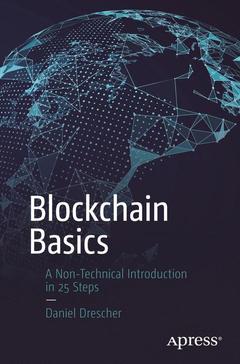Description
Blockchain Basics, 1st ed.
A Non-Technical Introduction in 25 Steps
Author: Drescher Daniel
Language: English
Subjects for Blockchain Basics:
Keywords
blockchain; distributed systems; peer-to-peer systems; distributed ledger technologies; distributed consensus; consentaneous; Raft; Paxos; hash puzzle; proof of work; proof of ownership; immutable ledger; Sybil attack; cryptography; asymmetric cryptography; private public key cryptography; cryptographic hash function; hash pointers; cryptographic currencies; double spending
Support: Print on demand
Description
/li>Contents
/li>Biography
/li>Comment
/li>
In 25 concise steps, you will learn the basics of blockchain technology. No mathematical formulas, program code, or computer science jargon are used. No previous knowledge in computer science, mathematics, programming, or cryptography is required. Terminology is explained through pictures, analogies, and metaphors.
This book bridges the gap that exists between purely technical books about the blockchain and purely business-focused books. It does so by explaining both the technical concepts that make up the blockchain and their role in business-relevant applications.
What You'll Learn
- What the blockchain is
- Why it is needed and what problem it solves
- Why there is so much excitement about the blockchain and its potential
- Major components and their purpose
- How various components of the blockchain work and interact
- Limitations, why they exist, and what has been done to overcome them
- Major application scenarios
Who This Book Is For
Everyone who wants to get a general idea of what blockchain technology is, how it works, and how it will potentially change the financial system as we know it
Stage 1: Terminology and Technical Foundations.-
Step 1: Thinking in Layers and Aspects.-
Step 2: Seeing the Big Picture.-
Step 3: Recognizing the Potential.-
Stage 2: Why the Blockchain Is Needed.-
Step 4: Discovering the Core Problem.-
Step 5: Disambiguating the Term.-
Step 6: Understanding the Nature of Ownership.-
Step 7: Spending Money Twice.-
Stage 3: How the Blockchain Works.-
Step 8: Planning the Blockchain.-
Step 9: Documenting Ownership.-
Step 10: Hashing Data.-
Step 11: Hashing in the Real World.-
Step 12: Identifying and Protecting User Accounts.-
Step 13: Authorizing Transactions.-
Step 14: Storing Transaction Data.-
Step 15: Using the Data Store.-
Step 16: Protecting the Data Store.-
Step 17: Distributing the Data Store Among Peers.-
Step 18: Verifying and Adding Transactions.-
Step 19: Choosing a Transaction History.-
Step 20: Paying for Integrity.-
Step 21: Bringing the Pieces Together.-
Stage 4: Limitations and Their Solutions.-
Step 22: Seeing the Limitations.-
Step 23: Reinventing the Blockchain.-
Stage 5: Using the Blockchain, Summary, and Outlook
Step 24: Using the Blockchain.-
Step 25: Summarizing and Going Further.-
Bibliography.-
Daniel Drescher is an experienced banking professional who has held positions in electronic security trading in a range of banks. His recent activities have focused on automation, machine learning and big data in the context of security trading. Amongst others, Daniel holds a Doctorate in Econometrics from the Technical University of Berlin and an MSc in Software Engineering from the University of Oxford.
Teaches core concepts and uses of blockchain technology, without relying on mathematical formulas or computer science jargon
Shows how financial and commercial applications of the blockchain work in practice
Teaches the essential blockchain format underlying all the technology’s specific applications




